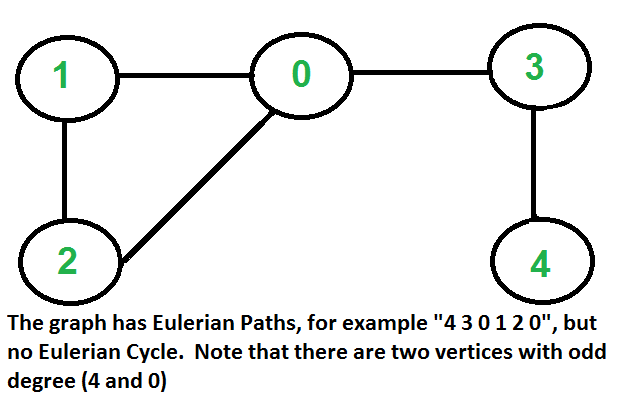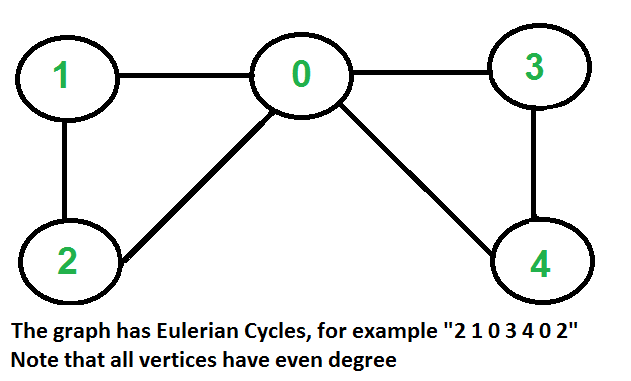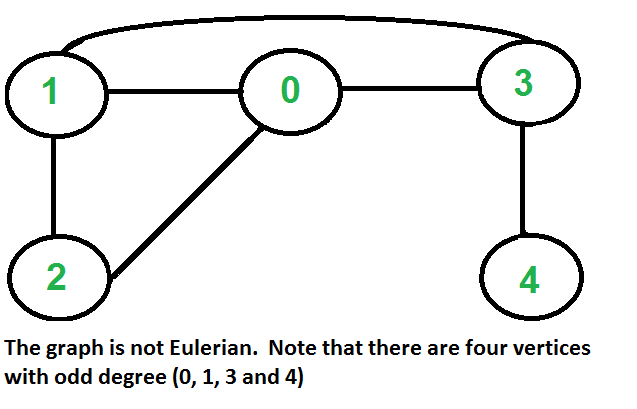本文概述
欧拉路径是图形中的一条路径, 该路径恰好一次访问每个边。欧拉回路是一条始于和终止于同一顶点的欧拉路径。



如何查找给定图是否为欧拉图?
问题与以下问题相同。 "有可能画出给定的图形而无需从纸上抬起铅笔, 也不必多次描画任何边缘。"
如果图形具有欧拉循环, 则称为欧拉曲线;如果图形具有欧拉路径, 则称为半欧拉曲线。问题似乎类似于哈密顿路径这是一般图的NP完全问题。幸运的是, 我们可以发现给定图在多项式时间内是否具有欧拉路径。实际上, 我们可以在O(V + E)时间找到它。
以下是具有欧拉路径和循环的无向图的一些有趣特性。我们可以使用这些属性来查找图是否为欧拉图。
欧拉循环
如果满足以下两个条件, 则无向图具有欧拉循环。
….a)所有非零度的顶点都已连接。我们不在乎零度的顶点, 因为它们不属于欧拉循环或路径(我们仅考虑所有边)。
….b)所有顶点都具有偶数度。
欧拉路径
如果满足以下两个条件, 则无向图具有欧拉路径。
….a)与欧拉循环的条件(a)相同
….b)如果零个或两个顶点具有奇数度, 而所有其他顶点具有偶数度。请注意, 在无向图中, 只有一个具有奇数度的顶点是不可能的(在无向图中, 所有度的总和始终是偶数)
请注意, 没有边的图被视为欧拉图, 因为没有要遍历的边。
这是如何运作的?
在欧拉路径中, 每次访问顶点v时, 我们都会走过两个未访问的边缘, 且端点的端点为v。因此, 欧拉路径中的所有中间顶点都必须具有均匀度。对于欧拉循环, 任何顶点都可以是中间顶点, 因此所有顶点都必须具有偶数度。
C ++
// A C++ program to check if a given graph is Eulerian or not
#include<iostream>
#include <list>
using namespace std;
// A class that represents an undirected graph
class Graph
{
int V; // No. of vertices
list< int > *adj; // A dynamic array of adjacency lists
public :
// Constructor and destructor
Graph( int V) { this ->V = V; adj = new list< int >[V]; }
~Graph() { delete [] adj; } // To avoid memory leak
// function to add an edge to graph
void addEdge( int v, int w);
// Method to check if this graph is Eulerian or not
int isEulerian();
// Method to check if all non-zero degree vertices are connected
bool isConnected();
// Function to do DFS starting from v. Used in isConnected();
void DFSUtil( int v, bool visited[]);
};
void Graph::addEdge( int v, int w)
{
adj[v].push_back(w);
adj[w].push_back(v); // Note: the graph is undirected
}
void Graph::DFSUtil( int v, bool visited[])
{
// Mark the current node as visited and print it
visited[v] = true ;
// Recur for all the vertices adjacent to this vertex
list< int >::iterator i;
for (i = adj[v].begin(); i != adj[v].end(); ++i)
if (!visited[*i])
DFSUtil(*i, visited);
}
// Method to check if all non-zero degree vertices are connected.
// It mainly does DFS traversal starting from
bool Graph::isConnected()
{
// Mark all the vertices as not visited
bool visited[V];
int i;
for (i = 0; i < V; i++)
visited[i] = false ;
// Find a vertex with non-zero degree
for (i = 0; i < V; i++)
if (adj[i].size() != 0)
break ;
// If there are no edges in the graph, return true
if (i == V)
return true ;
// Start DFS traversal from a vertex with non-zero degree
DFSUtil(i, visited);
// Check if all non-zero degree vertices are visited
for (i = 0; i < V; i++)
if (visited[i] == false && adj[i].size() > 0)
return false ;
return true ;
}
/* The function returns one of the following values
0 --> If grpah is not Eulerian
1 --> If graph has an Euler path (Semi-Eulerian)
2 --> If graph has an Euler Circuit (Eulerian) */
int Graph::isEulerian()
{
// Check if all non-zero degree vertices are connected
if (isConnected() == false )
return 0;
// Count vertices with odd degree
int odd = 0;
for ( int i = 0; i < V; i++)
if (adj[i].size() & 1)
odd++;
// If count is more than 2, then graph is not Eulerian
if (odd > 2)
return 0;
// If odd count is 2, then semi-eulerian.
// If odd count is 0, then eulerian
// Note that odd count can never be 1 for undirected graph
return (odd)? 1 : 2;
}
// Function to run test cases
void test(Graph &g)
{
int res = g.isEulerian();
if (res == 0)
cout << "graph is not Eulerian\n" ;
else if (res == 1)
cout << "graph has a Euler path\n" ;
else
cout << "graph has a Euler cycle\n" ;
}
// Driver program to test above function
int main()
{
// Let us create and test graphs shown in above figures
Graph g1(5);
g1.addEdge(1, 0);
g1.addEdge(0, 2);
g1.addEdge(2, 1);
g1.addEdge(0, 3);
g1.addEdge(3, 4);
test(g1);
Graph g2(5);
g2.addEdge(1, 0);
g2.addEdge(0, 2);
g2.addEdge(2, 1);
g2.addEdge(0, 3);
g2.addEdge(3, 4);
g2.addEdge(4, 0);
test(g2);
Graph g3(5);
g3.addEdge(1, 0);
g3.addEdge(0, 2);
g3.addEdge(2, 1);
g3.addEdge(0, 3);
g3.addEdge(3, 4);
g3.addEdge(1, 3);
test(g3);
// Let us create a graph with 3 vertices
// connected in the form of cycle
Graph g4(3);
g4.addEdge(0, 1);
g4.addEdge(1, 2);
g4.addEdge(2, 0);
test(g4);
// Let us create a graph with all veritces
// with zero degree
Graph g5(3);
test(g5);
return 0;
}Java
// A Java program to check if a given graph is Eulerian or not
import java.io.*;
import java.util.*;
import java.util.LinkedList;
// This class represents an undirected graph using adjacency list
// representation
class Graph
{
private int V; // No. of vertices
// Array of lists for Adjacency List Representation
private LinkedList<Integer> adj[];
// Constructor
Graph( int v)
{
V = v;
adj = new LinkedList[v];
for ( int i= 0 ; i<v; ++i)
adj[i] = new LinkedList();
}
//Function to add an edge into the graph
void addEdge( int v, int w)
{
adj[v].add(w); // Add w to v's list.
adj[w].add(v); //The graph is undirected
}
// A function used by DFS
void DFSUtil( int v, boolean visited[])
{
// Mark the current node as visited
visited[v] = true ;
// Recur for all the vertices adjacent to this vertex
Iterator<Integer> i = adj[v].listIterator();
while (i.hasNext())
{
int n = i.next();
if (!visited[n])
DFSUtil(n, visited);
}
}
// Method to check if all non-zero degree vertices are
// connected. It mainly does DFS traversal starting from
boolean isConnected()
{
// Mark all the vertices as not visited
boolean visited[] = new boolean [V];
int i;
for (i = 0 ; i < V; i++)
visited[i] = false ;
// Find a vertex with non-zero degree
for (i = 0 ; i < V; i++)
if (adj[i].size() != 0 )
break ;
// If there are no edges in the graph, return true
if (i == V)
return true ;
// Start DFS traversal from a vertex with non-zero degree
DFSUtil(i, visited);
// Check if all non-zero degree vertices are visited
for (i = 0 ; i < V; i++)
if (visited[i] == false && adj[i].size() > 0 )
return false ;
return true ;
}
/* The function returns one of the following values
0 --> If grpah is not Eulerian
1 --> If graph has an Euler path (Semi-Eulerian)
2 --> If graph has an Euler Circuit (Eulerian) */
int isEulerian()
{
// Check if all non-zero degree vertices are connected
if (isConnected() == false )
return 0 ;
// Count vertices with odd degree
int odd = 0 ;
for ( int i = 0 ; i < V; i++)
if (adj[i].size()% 2 != 0 )
odd++;
// If count is more than 2, then graph is not Eulerian
if (odd > 2 )
return 0 ;
// If odd count is 2, then semi-eulerian.
// If odd count is 0, then eulerian
// Note that odd count can never be 1 for undirected graph
return (odd== 2 )? 1 : 2 ;
}
// Function to run test cases
void test()
{
int res = isEulerian();
if (res == 0 )
System.out.println( "graph is not Eulerian" );
else if (res == 1 )
System.out.println( "graph has a Euler path" );
else
System.out.println( "graph has a Euler cycle" );
}
// Driver method
public static void main(String args[])
{
// Let us create and test graphs shown in above figures
Graph g1 = new Graph( 5 );
g1.addEdge( 1 , 0 );
g1.addEdge( 0 , 2 );
g1.addEdge( 2 , 1 );
g1.addEdge( 0 , 3 );
g1.addEdge( 3 , 4 );
g1.test();
Graph g2 = new Graph( 5 );
g2.addEdge( 1 , 0 );
g2.addEdge( 0 , 2 );
g2.addEdge( 2 , 1 );
g2.addEdge( 0 , 3 );
g2.addEdge( 3 , 4 );
g2.addEdge( 4 , 0 );
g2.test();
Graph g3 = new Graph( 5 );
g3.addEdge( 1 , 0 );
g3.addEdge( 0 , 2 );
g3.addEdge( 2 , 1 );
g3.addEdge( 0 , 3 );
g3.addEdge( 3 , 4 );
g3.addEdge( 1 , 3 );
g3.test();
// Let us create a graph with 3 vertices
// connected in the form of cycle
Graph g4 = new Graph( 3 );
g4.addEdge( 0 , 1 );
g4.addEdge( 1 , 2 );
g4.addEdge( 2 , 0 );
g4.test();
// Let us create a graph with all veritces
// with zero degree
Graph g5 = new Graph( 3 );
g5.test();
}
}
// This code is contributed by Aakash Hasijapython
# Python program to check if a given graph is Eulerian or not
#Complexity : O(V+E)
from collections import defaultdict
#This class represents a undirected graph using adjacency list representation
class Graph:
def __init__( self , vertices):
self .V = vertices #No. of vertices
self .graph = defaultdict( list ) # default dictionary to store graph
# function to add an edge to graph
def addEdge( self , u, v):
self .graph[u].append(v)
self .graph[v].append(u)
#A function used by isConnected
def DFSUtil( self , v, visited):
# Mark the current node as visited
visited[v] = True
#Recur for all the vertices adjacent to this vertex
for i in self .graph[v]:
if visited[i] = = False :
self .DFSUtil(i, visited)
'''Method to check if all non-zero degree vertices are
connected. It mainly does DFS traversal starting from
node with non-zero degree'''
def isConnected( self ):
# Mark all the vertices as not visited
visited = [ False ] * ( self .V)
# Find a vertex with non-zero degree
for i in range ( self .V):
if len ( self .graph[i]) > 1 :
break
# If there are no edges in the graph, return true
if i = = self .V - 1 :
return True
# Start DFS traversal from a vertex with non-zero degree
self .DFSUtil(i, visited)
# Check if all non-zero degree vertices are visited
for i in range ( self .V):
if visited[i] = = False and len ( self .graph[i]) > 0 :
return False
return True
'''The function returns one of the following values
0 --> If grpah is not Eulerian
1 --> If graph has an Euler path (Semi-Eulerian)
2 --> If graph has an Euler Circuit (Eulerian) '''
def isEulerian( self ):
# Check if all non-zero degree vertices are connected
if self .isConnected() = = False :
return 0
else :
#Count vertices with odd degree
odd = 0
for i in range ( self .V):
if len ( self .graph[i]) % 2 ! = 0 :
odd + = 1
'''If odd count is 2, then semi-eulerian.
If odd count is 0, then eulerian
If count is more than 2, then graph is not Eulerian
Note that odd count can never be 1 for undirected graph'''
if odd = = 0 :
return 2
elif odd = = 2 :
return 1
elif odd > 2 :
return 0
# Function to run test cases
def test( self ):
res = self .isEulerian()
if res = = 0 :
print "graph is not Eulerian"
elif res = = 1 :
print "graph has a Euler path"
else :
print "graph has a Euler cycle"
#Let us create and test graphs shown in above figures
g1 = Graph( 5 );
g1.addEdge( 1 , 0 )
g1.addEdge( 0 , 2 )
g1.addEdge( 2 , 1 )
g1.addEdge( 0 , 3 )
g1.addEdge( 3 , 4 )
g1.test()
g2 = Graph( 5 )
g2.addEdge( 1 , 0 )
g2.addEdge( 0 , 2 )
g2.addEdge( 2 , 1 )
g2.addEdge( 0 , 3 )
g2.addEdge( 3 , 4 )
g2.addEdge( 4 , 0 )
g2.test();
g3 = Graph( 5 )
g3.addEdge( 1 , 0 )
g3.addEdge( 0 , 2 )
g3.addEdge( 2 , 1 )
g3.addEdge( 0 , 3 )
g3.addEdge( 3 , 4 )
g3.addEdge( 1 , 3 )
g3.test()
#Let us create a graph with 3 vertices
# connected in the form of cycle
g4 = Graph( 3 )
g4.addEdge( 0 , 1 )
g4.addEdge( 1 , 2 )
g4.addEdge( 2 , 0 )
g4.test()
# Let us create a graph with all veritces
# with zero degree
g5 = Graph( 3 )
g5.test()
#This code is contributed by Neelam YadavC#
// A C# program to check if a given graph is Eulerian or not
using System;
using System.Collections.Generic;
// This class represents an undirected graph using adjacency list
// representation
public class Graph
{
private int V; // No. of vertices
// Array of lists for Adjacency List Representation
private List< int > []adj;
// Constructor
Graph( int v)
{
V = v;
adj = new List< int >[v];
for ( int i=0; i<v; ++i)
adj[i] = new List< int >();
}
//Function to add an edge into the graph
void addEdge( int v, int w)
{
adj[v].Add(w); // Add w to v's list.
adj[w].Add(v); //The graph is undirected
}
// A function used by DFS
void DFSUtil( int v, bool []visited)
{
// Mark the current node as visited
visited[v] = true ;
// Recur for all the vertices adjacent to this vertex
foreach ( int i in adj[v]){
int n = i;
if (!visited[n])
DFSUtil(n, visited);
}
}
// Method to check if all non-zero degree vertices are
// connected. It mainly does DFS traversal starting from
bool isConnected()
{
// Mark all the vertices as not visited
bool []visited = new bool [V];
int i;
for (i = 0; i < V; i++)
visited[i] = false ;
// Find a vertex with non-zero degree
for (i = 0; i < V; i++)
if (adj[i].Count != 0)
break ;
// If there are no edges in the graph, return true
if (i == V)
return true ;
// Start DFS traversal from a vertex with non-zero degree
DFSUtil(i, visited);
// Check if all non-zero degree vertices are visited
for (i = 0; i < V; i++)
if (visited[i] == false && adj[i].Count > 0)
return false ;
return true ;
}
/* The function returns one of the following values
0 --> If grpah is not Eulerian
1 --> If graph has an Euler path (Semi-Eulerian)
2 --> If graph has an Euler Circuit (Eulerian) */
int isEulerian()
{
// Check if all non-zero degree vertices are connected
if (isConnected() == false )
return 0;
// Count vertices with odd degree
int odd = 0;
for ( int i = 0; i < V; i++)
if (adj[i].Count%2!=0)
odd++;
// If count is more than 2, then graph is not Eulerian
if (odd > 2)
return 0;
// If odd count is 2, then semi-eulerian.
// If odd count is 0, then eulerian
// Note that odd count can never be 1 for undirected graph
return (odd==2)? 1 : 2;
}
// Function to run test cases
void test()
{
int res = isEulerian();
if (res == 0)
Console.WriteLine( "graph is not Eulerian" );
else if (res == 1)
Console.WriteLine( "graph has a Euler path" );
else
Console.WriteLine( "graph has a Euler cycle" );
}
// Driver method
public static void Main(String []args)
{
// Let us create and test graphs shown in above figures
Graph g1 = new Graph(5);
g1.addEdge(1, 0);
g1.addEdge(0, 2);
g1.addEdge(2, 1);
g1.addEdge(0, 3);
g1.addEdge(3, 4);
g1.test();
Graph g2 = new Graph(5);
g2.addEdge(1, 0);
g2.addEdge(0, 2);
g2.addEdge(2, 1);
g2.addEdge(0, 3);
g2.addEdge(3, 4);
g2.addEdge(4, 0);
g2.test();
Graph g3 = new Graph(5);
g3.addEdge(1, 0);
g3.addEdge(0, 2);
g3.addEdge(2, 1);
g3.addEdge(0, 3);
g3.addEdge(3, 4);
g3.addEdge(1, 3);
g3.test();
// Let us create a graph with 3 vertices
// connected in the form of cycle
Graph g4 = new Graph(3);
g4.addEdge(0, 1);
g4.addEdge(1, 2);
g4.addEdge(2, 0);
g4.test();
// Let us create a graph with all veritces
// with zero degree
Graph g5 = new Graph(3);
g5.test();
}
}
// This code contributed by PrinciRaj1992输出如下:
graph has a Euler path
graph has a Euler cycle
graph is not Eulerian
graph has a Euler cycle
graph has a Euler cycle时间复杂度:O(V + E)
下一篇文章:
有向图的欧拉路径和电路。
Fleury的算法可以打印欧拉路径或电路?
参考文献:
http://en.wikipedia.org/wiki/Eulerian_path
如果发现任何不正确的地方, 或者你想分享有关上述主题的更多信息, 请发表评论

![从字法上最小长度N的排列,使得对于正好为K个索引,a[i] a[i]+1](https://www.lsbin.com/wp-content/themes/begin%20lts/img/loading.png)